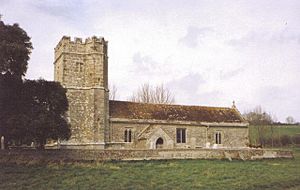Whitcombe Church facts for kids
Quick facts for kids Whitcombe Church |
|
|---|---|
 |
|
| Location | Whitcombe, Dorset, England |
| Built | 12th century |
|
Listed Building – Grade I
|
|
| Official name: Parish Church (Dedication Unknown) | |
| Designated | 26 July 1956 |
| Reference no. | 105986 |
| Lua error in Module:Location_map at line 420: attempt to index field 'wikibase' (a nil value). | |
Whitcombe Church is a very old and special church located in a village called Whitcombe in Dorset, England. It was built a long, long time ago in the 12th century, which means it's over 800 years old! This church is so important that it's officially recognized as a Grade I listed building. This means it's one of the most important historic buildings in England. Today, it's looked after by a group called the Churches Conservation Trust, who help protect old churches like this one.
Contents
A Journey Through Time
The land where Whitcombe Church stands has been a place of worship for a very long time. Even before the current church was built, people worshipped here during the Anglo-Saxon era. You can still find pieces of two Saxon crosses, which are ancient stone markers, on the site today!
The oldest part of the church, called the nave (the main area where people sit), was built in the 12th century. Later, in the 15th century, the chancel (the part near the altar) was added. The tall tower you see today was built even later, in the late 16th century. Each part tells a story of how the church grew over hundreds of years.
Inside the Church
Stepping inside Whitcombe Church is like taking a trip back in time. You can see amazing wall paintings that are very old. One of these paintings shows St Christopher, a famous saint.
There's also a special font made from Purbeck marble. This font is where babies are baptized and it dates all the way back to the 13th century! It's incredible to think about how many people have been part of ceremonies around this very font.
The Poet's Connection
Whitcombe Church has a special link to a famous English writer and poet named William Barnes. He worked as a minister, called a curate, at Whitcombe from 1847 to 1852. He returned again in 1862. It's said that he preached both his very first and his very last sermons in this church.
William Barnes was a very talented person. He wrote over 800 poems! Many of his poems were written in the local Dorset dialect, which made them unique. He also wrote many other things, including a detailed English grammar book. For this book, he used examples from more than 70 different languages!
Caring for Old Churches
Whitcombe Church was declared a "redundant church" on October 29, 1971. This means it was no longer used for regular church services. However, it was then taken over by the Churches Conservation Trust on February 12, 1973. This wonderful charity works to protect and preserve historic churches across England that are no longer in use. They make sure these beautiful buildings are kept safe for everyone to enjoy and learn from.
See also

